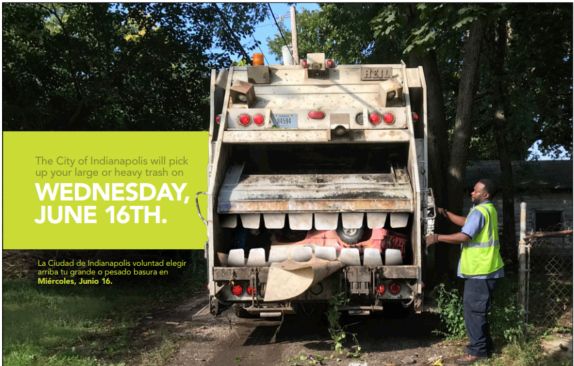Our planet can’t handle the amount of trash we produce—around two billion tons of it every year. The United States alone generated 292 million tons of waste in 2018. Experts estimate that a third of this garbage is not managed in environmentally friendly ways.
Improperly disposed waste pollutes waterways, harms ecosystems, and threatens waste, rain, and stormwater systems themselves. While solving this problem long-term requires fundamental changes, such as new waste management systems and regulations, individual behavior matters—and can be felt today. Small actions, like leaving an open paint can outside in the rain or throwing recyclables into the garbage, can have a big impact on the environment.
Behavioral insights can help encourage proper disposal. After all, what people do with their garbage is a behavior in itself. Recycle? Compost? Dump it? However, the actions we take depend on our immediate surroundings, which are shaped by waste management services, local governments, organizations, and urban planning. We advise on strategies, recommending actions that will shift and improve these essential behaviours.
Here are three ways we can apply a behavioral insights approach to promote more sustainable waste disposal.
Use Behavioural Insights To Reduce Littering
Littering is a notoriously tough behavior to shift. Conventional methods focus on public education campaigns to convince people that littering is morally wrong. These tactics persist even though they don’t work well. Even messaging leveraging behavioral science concepts is not very effective if good disposal options aren’t conveniently available as well.
That’s why improving choice architecture is crucial. When people are deciding what to do with their trash, they need easy ways to dispose of it correctly. This can look like reducing the friction (i.e., the effort required to take an action) associated with proper disposal (e.g., improving the look and location of trash cans).
How Using Behavioural Insights Can Reverse Bad Habits
For example, BIT partnered with elementary schools to reduce single-use plastics in lunchrooms. We found that having schools provide lunches in reusable containers (and incentivizing students to return them once they were done eating) was more effective than trying to incentivize students to bring a reusable container from home. The strategy that encouraged sustainable behavior was the one that made it easier.
Another proven strategy for reducing litter is changing the social norms of a space (e.g., cleaning up a location or modeling proper litter disposal). One avenue to improving public spaces may be through property owners. Our work with cities shows that simple communication nudges can be a cost-effective way to motivate them to bring their buildings into compliance with local regulations.
Increase participation in disposal programs
Many local governments already provide services for people to safely dispose of large household goods and hazardous waste. But these services are often designed with high friction costs.
For example, consider the hassle a resident experiences when using a once-per-month heavy trash drop-off site located across town. Even home pick-up services require people to remember to set out items on a specific date—a new behavior which is no easy task for residents to take up, especially if they have strong waste disposal habits or are already cognitively burdened.
The team at BIT has applied timely reminders and social norms messaging to increase uptake of underused waste disposal services. We helped local partners increase food recycling bin orders by 1500% and reduce the number of residents who missed recycling collection dates. Reducing food waste is also an important concern for better waste management. We also partnered with Keep Indianapolis Beautiful to encourage residents to take part in the city’s heavy item pick up program.


Above: The mailer BIT designed leverages deadlines among other behavioral insights to encourage proper waste disposal.
We sent Indianapolis residents a behaviorally-informed mailer and a magnet about the program, prompting them to participate. On the first collection date after the intervention, we found that households who received the mailer were 55.1% more likely to properly set out their bulk items than those who did not receive the mailer.
Encourage accurate waste separation
To correctly dispose of waste, people often have to separate it into different containers. Unfortunately, waste separation rules can be complicated and vary between cities—even between someone’s home and their workplace. Reducing uncertainty around the segregation of trash can prevent recyclable trash being sent to landfill.
The key to encouraging waste separation—or any behavior—is making it as easy as possible to do. We recommend implementing single-stream recycling or other waste-separation technologies that reduce the cognitive burden of doing it manually.
When these technologies are not available, simple and timely instructions can help. In one instance, we found that placing graphic instructions on disposal bins highlighting common errors increased the quality of dry waste separation between 7.2 and 10.7 percentage points. Behaviorally-informed rewards, such as prize draws, may also be a promising strategy for incentivizing proper waste separation.
The Importance of Promoting Better Waste Management Using Behavioural Insights
Most people want to dispose of their trash properly. But they come up against barriers that prevent them from acting on their good intentions. As governments, urban planners, and other institutions design and improve waste management infrastructure, it is imperative that they do so with an understanding of how humans behave. Our planet depends on it.
We use what we know about behavioural insights to understand why people behave the way they do. From the research on this and what people best react to, we can develop ways to improve waste management.
You can see our full range of services here.
To learn more about how we can apply behavioral insights to your waste management program, please contact Marcos Pelenur.





